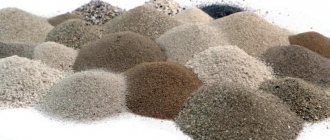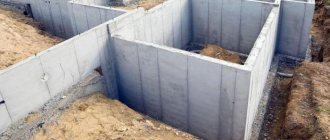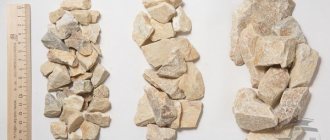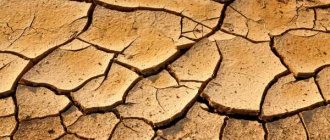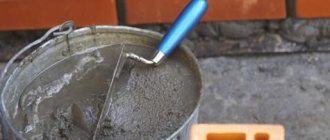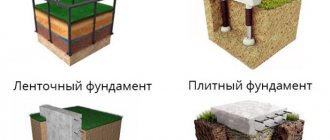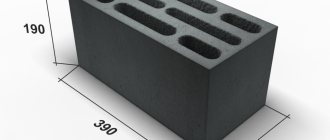Concrete mass is widely used in construction, being the basis of almost any building. To prepare the mixture correctly, we figure out which sand is best for concrete, what it does to the composition, what types there are and how they differ. You will also learn what to look for when choosing, what properties the right sand should have, how to check its quality and find out the proportions.
Sand can be different, and will affect the properties of concrete differently Source pol-inform.ru
General requirements
Requirements for raw materials used to produce the mixture are specified by GOSTs. Their list includes indicators such as:
- percentage of dust particles (size less than 0.14 mm) – no more than 10% of the total weight;
- amount of dust and clay impurities – no more than 3%;
- content of large particles (0.5 cm or more in diameter) – 5% or less;
- fractions larger than 1 cm are not allowed at all;
- the material should not contain any organic impurities.
Only building materials that have undergone additional processing - washing with water and sifting using special machines - can meet these requirements.
Definition of quality
Sand with high-quality properties is necessary for the production of long-term PB monoliths and depends on its chemical composition, occurrence zone and, partly, on fishing technology. The existing standards strictly link the requirements for the strength properties and ductility of such a solution, which depends on:
- Fractional grain size.
- Bulk density per 1 m³. The average value of this indicator is in the range of 1.31 - 2.0 t/m³.
- Configurations of grain elements influencing precipitation in the composition.
- The presence of dust and contaminating foreign matter.
Raw humidity should not exceed 5.0%. During precipitation, this value increases to 10.0%. This indicator is taken into account when water is added to the mixture.
At a construction site, the degree of humidity can be determined in the following way. If the raw material is squeezed into a lump, it must crumble. When this does not happen, the moisture is more than 4.5%. Despite the simplicity and reliability of the visual determination method, in order to choose which sand is best for concrete, it is still more reliable to check the percentage in the laboratory.
Varieties
This building material is classified according to the following criteria:
- origin – natural and artificial;
- place of production - river, quarry, sea;
- processing method - unprocessed, washed, seeded;
- bulk mass – solid and porous;
- mineral composition - dolomite, limestone, feldspathic, quartz, marble, perlite;
- particle size - small, medium or large.
Types of raw materials differ in strength, quality and other properties. Not all of them are suitable for screeding and making concrete blocks.
Differences between quarry and river sand
When creating concrete, quarry or river sand is often used. There are several differences between them, namely:
- The quarry sand grain has a rough shape, while the river sand grain has a smooth shape. Because of this, their adhesion to crushed stone differs - the first type is distributed easily, while the second requires constant stirring.
- The building material extracted from reservoirs is uniform in size fractions.
- Quarry sand contains much more clay and dust.
- The price of river building materials is higher.
When choosing a product, you need to know the nature of the work for which you plan to use it. For plastering walls, creating masonry, building pillows for the foundation, the quarry type is suitable. Sand for semi-dry screed, pouring blocks and other structures, constructing foundations and elements on frames must be river or sea.
Approximate prices
Obviously, the cost of sand is higher, the more manipulations had to be done with it during extraction and cleaning.
The cheapest is quarry unwashed and unsown. Its price per cube ranges from 300 to 400 rubles. Quarry sand purified by water or sifting for construction work will cost from 550 to 700 rubles per 1 m3 with delivery.
River sand is significantly more expensive than quarry sand. Its price starts at 750 rubles and ends at 950 rubles/m3.
Fractionated quartz sand is the most expensive. When purchasing from 10 tons (1 KAMAZ), its price with delivery is from 4,500 rubles per cubic meter.
Processing and preparation
Based on the type of processing during and after mining, building materials are divided into two types:
- Alluvial. It is processed and extracted in quarries using a device called a decanter. In it, the mass settles in water, after which the liquid is drained, washing away the remaining clay and dust. The result is a pure product.
- Seeded. It is processed with a mechanical sifter, as a result of which all unnecessary elements are removed from the building material. Rarely used due to the labor-intensive and expensive process.
Processing is carried out only on sand mass extracted from quarries.
Which sand to choose for making concrete
The choice of raw materials for concrete depends on the required grade of material. For M50-M150 it is better to use medium-grain options, as they are cheaper. If you are building a foundation, wall or road (you should use M200-M300 concrete for them), you will need a higher quality sand composition with large particles and no impurities. When creating durable and super-strong concrete (M350 and above), only coarse-grained types of sand are suitable.
To determine which sand is best for construction, you need to consider the type of room. So, for work in industrial and public buildings, it is worth giving preference to high-quality river (or sea) varieties that have been sifted and carefully checked for the presence of any impurities. This is due to the fact that the structures in them are subject to heavy loads: shocks, vibrations, the weight of equipment and people.
Inexpensive quarry varieties of sand are chosen for finishing residential premises and apartments. The best option is washed building material with a medium grain size.
Number of layers
The walls are finished in three stages, each with individual characteristics of application and density of the mixture; the proportion of sand and cement does not depend on these characteristics:
- the initial layer is a spray, a liquid creamy cement composition is thrown onto the wall without gaps in a dense continuous layer, filling the roughness. After hardening, the next one is applied;
- the main one is soil. Application thickness up to one and a half centimeters. The composition of the concrete is the same as for spraying. The mortar is poured in one span of the lighthouses, the excess plaster is cut off from bottom to top and leveled horizontally using a rule. The thick layer is divided into two or three stages with incomplete drying for setting between each other;
- finishing coat - a covering to correct minor flaws, tool marks, scratches, as soon as the base primer dries. For it, the composition is prepared on sand cleared of debris through a fine sieve. For a minimum layer thickness, mix the solution in the same way as spraying.
